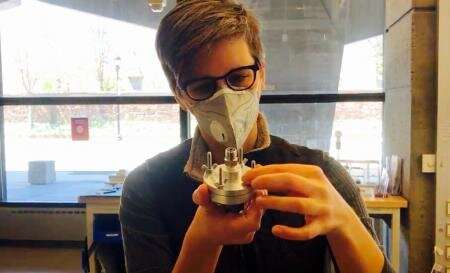
At a time when hospitals are running low on personal protective equipment, a Yale-built system that tests non-certified respirators and masks has opened up valuable new options for healthcare workers.
Typically, hospitals have a steady supply of respirators certified by the National Institute for Occupational Safety and Health (NIOSH). The critical shortage of these masks, caused by the COVID-19 outbreak, makes it crucial to find decent alternatives for healthcare workers. But a lot of the non-certified masks in circulation are of unknown quality and safety. To identify products that might potentially be unsuitable, Yale researchers developed a system to test the quality of these respirators. It’s a solution to an unprecedented situation, made possible by the collaboration of researchers in different fields.
“Testing for masks on your medical campus isn’t normal, but it’s necessary right now—like many things we’re doing now in the state of COVID-19, it’s all about what we need to do for patients and our frontline healthcare workers,” said Lisa Lattanza, chair of Orthopaedics & Rehabilitation. “We want to protect our frontline heroes from getting sick, and the ability to test on campus just gives us more options to do that in the time of a really tight supply chain.”
The testing apparatus came out of the Coalition for Health Innovation in Medical Emergencies (CHIME), a multidisciplinary group organized to address innovations related to COVID-19. Operated at the Center for Engineering Innovation & Design (CEID), the tests determine how well the respirators filter out aerosols, as well as how well they allow their wearers to breathe.
Conducted by Senior Research Scientist Lawrence Wilen, Associate Research Scientist Katherine Schilling, and CEID Design Fellow Antonio Medina, with remote guidance from Associate Professor Drew Gentner (Chemical & Environmental Engineering), the tests have been run over the last few weeks and are paying off. Lattanza noted that she and others at the School of Medicine have identified at least one available supply of masks that they can use at Yale-New Haven Hospital in place of their typical 3M N95 masks (so called because they can filter out at least 95% of airborne particles). It’s also allowed them to rule out other available, but inferior, masks.
“There are several KN95 masks that don’t meet criteria, and without this testing we would have been in a quandary as to whether to use them, which would have been dangerous,” Lattanza said. “So the testing has helped in both ways—ferreting out bad masks and letting us know what’s good that we can order more of.”
About 50 masks have been tested at the CEID so far—go here for a paper on the results. The results, showing a wide range of quality, are shared with Lattanza and Yale Environmental Health & Safety (EHS), which conducts its own tests on how well the masks fit. Wilen said the tests at the CEID don’t determine directly which masks to use, but provide data that allow Lattanza and her colleagues to make informed decisions.
“We see this as sort of a pipeline—in the end they’re trying to come to some decisions about which ones have the best chance of being the highest quality,” he said. “With this information, they can come up with a priority list, and if they start at the top and go down, it optimizes their chances of doing better.”
Describing the process as a “decision tree,” Schilling said they rank each respirator they test with a letter grade.
“Their decisions are a little more complicated than just our results,” adding that there are several criteria Yale health officials consider beyond the CEID tests. “Our information is one aspect that feeds into the overall picture, because they’re the ones who know their end uses.”
Many of the masks that Yale-New Haven Health has received are from donors, often alumni based in China. They’ll send samples of the masks to Yale, and Lattanza brings them to the CEID and EHS. If a sample performs well on the tests, Lattanza then asks the donor to send more of the same kind. The testing system also helps her make decisions about purchases.
Source: Read Full Article